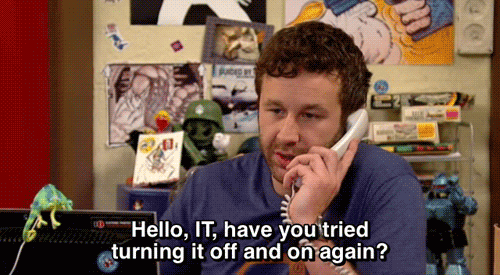The Reference Interview:
IT Style
What is the Reference Interview?
a conversation between a librarian and a library user, usually at a reference desk, in which the librarian responds to the user's initial explanation of their information need by first attempting to clarify that need and then by directing the user to appropriate information resources.
Step 1: Establishing Rapport
Face-2-Face > Phone > Email
7% is your words.
38% is voice tones
55% is your physiology
100% Communication
When we communicate in person, we have the benefit of body language or tone of voice. With e-mail, we have only the words on the page, and those words can easily be misunderstood. For the best outcome, avoid sarcasm, jokes, slang, terse replies, or using all caps. Choose your words thoughtfully, stick to the essentials, and always be polite.
Step 2: Determining the Question

Ask to understand
the user's
situation.
What do they do? How does this affect their job? Does this pose an immediate problem to their day to day responsibilities?
ProTip: You can build better ticketing forms with this thought process.
Sense making
Sense making
A SenseMaking approach requires a focus on what people do, how they
do it, and why they do it that way, rather than on the objects that people do things with.
Ask open ended questions.
Use neutral questioning
who, what, when, where, why, how
Just making sure I understand, but is this what you mean?
Don't assume the user knows but don't assume the user doesn't know either.
Make an effort to visually see the problem. Let the user walk you through it.
Step 3: Developing strategy & communicating it to the user.
re: Ticket #13496 [ticket closed]
"Okay it's fixed now."
Document. Communicate. Share.
Let the user be informed of how the problem was solved or the solution created.
This also builds rapport & a better relationship.
Step 4: Follow up
How's it going?
Problem solved?
Solution working?
anything else....
Step 5: Closing the Interview
Keep lines for communication open & respond.
Tips & Tricks...
-
Find a shared vocabulary
-
Build a narrative -- involve users from the start to finding the solution
-
Be attentive to how the user responds, be actionable with what you learn
Conclusion
In the traditional ref interview, we spend more time learning about the user before answering the problem/question.
In IT Troubleshooting, we spend more time learning about the problem.
Conclusion
Spend more time learning about the user, focus on the process to getting the answer and keep the user involved in the strategy/solution.
My regrets for not being here. Enjoy the cat.
The Reference Interview: IT style
By whitni
The Reference Interview: IT style
Conference Presentation at Access 2016 in New Brunswick
- 2,392



